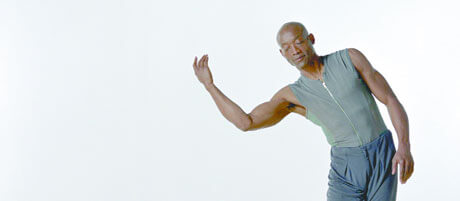Marking 20 years as a company man, Bill T. Jones reflects
It’s not that choreographer Bill T. Jones dislikes the French, it’s just not spoken in class. Dancers accustomed to arabesque penche-ing and developpe-ing will instead be asked to “Put your arms around the world” and “Step on the roach, now kill it. Kill it!”
It’s just one small difference in a company that been taking the expected and turning it on its head for 20 years now and though this anniversary season at BAM provides many reasons to look back and celebrate, it also marks a time of charging forward.
Certainly there’s new work. Jones defines his organization as the means of creating it and this season is no exception. There are premieres for the company and even a new solo for Jones, entitled “Chaconne,” which will hopefully put to rest the rumble that Jones was going the way of Cher after his last solo evening at Lincoln Center.
“I never said that,” Jones laughed, blaming the retirement rumor on something his publicist slipped into a release. “My intention is to find a way to keep dancing as long as I can. The rigors of trying to keep up with a company where the average age is about 25 can be counterproductive for a man who’s now 52. I want a safe harbor, a place where I can go and explore those things that are my own strengths and my own passions.”
A topic Jones has always been passionate about is the reading of race and another new, full-company work on the anniversary bill is “Reading, Mercy and the Artificial Nigger.”
“We’ve been discussing the diversity of this company and its leadership role and I wanted to test that,” Jones explained. “Can we bring forward a work from another medium that has troubling resonance for our very self-conscious era? This work uses the word nigger freely, but it’s also a work that has basic fundamentalist notions about religion in it.”
To present this narrative, taken from a Flannery O’Connor short story, Jones tapped company friend Susan Sarandon to “bring forth the story and have it read in the best possible way” so that Jones could “juxtapose the logic of my company, our racial logic, our sexual logic––anybody can dance with anybody––and movement that is basically abstract.”
“When you hear the nigger word,” Jones said, ”and you’re looking at a stage where there’s Chinese and Mexican and what have you, can you answer the question who is the nigger on that stage?”
Surely, it’s a dangerous question. But risk doesn’t scare Jones, rather it’s what moves him.
“Do people dare own what they truly feel about race?” he asked. “I say everything we feel about race is a lie.”
A big part of gaining the momentum necessary to make this risky new work is presenting popular pieces from the repertory. But even when the prolific Jones tries to look back he winds up creating. Witness this season’s revival of 1994’s watermark “Still/Here.” Jones fiddled with it so much it’s now titled “The Phantom Project: Still/Here Looking On.”
Jones is nothing if not a charming man. For example, he was literally able to charm the pants off his audience when he presented 1990’s “Last Supper at Uncle Tom’s Cabin/The Promised Land” and used volunteers from the community to dance with him in the nude.
That natural charisma has helped him weather attacks, such as the 1996 article in The New Yorker by dance critic Arlene Croce who, sight unseen, dismissed his piece “Still/Here” as “victim art.” The piece, which incorporates videotaped testimonials of the terminally ill, remains strong enough to make the cut for this anniversary season. While The New Yorker is still widely read, Croce was never heard from again.
So besides offering occasion to gloat, what does the process of curating a retrospective season do to things like long term planning?
“It does make one start to think differently about those things,” Jones, who’s been shopping in Harlem for a permanent home for his company, admitted.
“The idea is very much on the table and we expect to have a place within the next three or four years,” he added, beaming.
It all sounds a million years away from the dreams of a SUNY-Binghamtom freshman who met the love of his life, Arnie Zane, on Saint Patrick’s Day in 1971. Zane would lure Jones from college to Amsterdam and into a 17-year romantic and professional relationship that was one modern dance’s most fruitful.
Zane died from AIDS in 1988 and Jones’ company not only bears Zane’s name to this day, but will be dancing his works during the BAM season.
So what does it take to make the cut as a Bill T. Jones dancer? For Jones it boils down to a few simple questions: “I ask them what is at stake when you’re dancing? Are you here to be fabulous and look beautiful and maybe find a husband or is this dancing something essential to your life?”
Perhaps his own large family—Jones is the tenth of twelve children born to migrant farm working parents—so readily provides the metaphor of family.
“Bill can harangue,” Jones said with self-deprecation about his choreographic style. “I do get on a soapbox with them sometimes and I do push, but I also dote. I know there are people in my company now who could be my children. That’s a privilege as a gay man. Because, no, I don’t have any offspring, but I have a nurturing impulse and there’s plenty to nurture.”
And if you’re willing to accept the metaphor of dancers as his offspring, then Jones is the paterfamilias of an extended flock of champions.
“From the beginning, this company has always been responsive to who was doing the work,” he explained. “I’ve turned out so many choreographers because they were in the company. My dancers are constantly asked to solve problems. You ask, ‘What would you do in this situation? How do we make this transition? What do you think is going on?’ I don’t think that’s so original.”
But it’s clearly something Jones’ alumni thank him as seen by the return this season of several of them performing roles they originated under his tutelage.
Sean Curran, who explores cultural identity with his own company, is back with Arthur Aviles, whose signature nude style is emblematic of the innovation he has instilled in his own studio and artistic production company in the South Bronx.
Then there are Lawrence Goldhuber and Alexandra Beller, whose theme of body diversity continue Jones’ mission of ensuring that trained dancers have an impact besides music videos.
Has his imprint made a difference?
“I don’t know,” Jones replied. “Has it changed the ballet world? You could probably still count the number of black dancers dancing in the major companies in this country. I mean, they are there, but are there significantly that much more, never mind women who have big breasts or butts. There’s none.”
Still, all is not that bleak. After all, some of Jones’ most glorious work occurred during the Reagan era’s dark days of AIDS. Picket lines often gathered outside his performance venues. Does the current political climate feel like progress or déjà vu?
“Maybe this is a nostalgic feeling,” Jones admitted. “But there was more of a hopefulness back then. Now there’s a sense of being part of an overwhelming juggernaut of events that makes one feel less and less empowered.”
Still, Jones pointed to his own company and laughed, “These kids embrace Target. They embrace H&M. They know fashion, each brand name. I was macrobiotic when I was their age. When we go to Europe, they go looking for a McDonalds.
“They don’t have that knee jerk response that my generation did to corporate America. I wish they would, but I tell myself, ‘Bill don’t fall into the trap that older people fall into. The world did not stop with your youth. It continues. If you’re going to be a vital dance institution, you’ve got to keep that young blood moving through there. Keep it honest. Let it be devoted to a certain set of principles, but listen to them and let them help you build the organization.’”

































